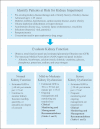Immune globulin therapy and kidney disease: Overview and screening, monitoring, and management recommendations
- PMID: 35595720
- PMCID: PMC9389421
- DOI: 10.1093/ajhp/zxac139
Immune globulin therapy and kidney disease: Overview and screening, monitoring, and management recommendations
Abstract
Purpose: This report calls attention to the potential risks of diminished kidney function when administering immune globulin (IG). The goal is to increase awareness of chronic kidney disease (CKD) and kidney function impairment in patients receiving IG and provide recommendations for screening, monitoring, and management to promote risk prevention and mitigation.
Summary: Human IG preparations for intravenous (IVIG) or subcutaneous (SCIG) administration are the mainstay of treatment in patients with primary immunodeficiency diseases. Increasingly, IVIG at high doses (1,000 to 2,400 mg/kg) is also used as a treatment for a variety of autoimmune and inflammatory conditions. Although some autoinflammatory disorders respond to a single course of IVIG therapy, the majority of patients require long-term, regular infusions, thereby increasing the overall risks. Often, both patients and physicians treating adults with IG are unaware of underlying CKD or kidney function impairment. This lack of awareness constitutes a major risk factor for potential worsening, particularly when using high doses of IVIG. Therefore, screening of all patients for CKD and kidney function impairment before the use of IG is essential. Identification of the cause of kidney impairment is strongly encouraged, as IG therapy may need to be modified.
Conclusion: As detailed here, there are potential risks to patients with impaired kidney function with administration of IG, particularly at high doses. Product selection, volume, route of administration, and rate of infusion may impact those with compromised kidney function. Therefore, screening of all patients for CKD and kidney function impairment before the use of IVIG and SCIG, as well as ongoing monitoring and management, is critical. As with all potential adverse drug reactions, the best approach is to prevent them.
Keywords: chronic kidney disease; high-dose immune globulin; immune globulin; intravenous immune globulin; renal impairment; subcutaneous immune globulin.
© American Society of Health-System Pharmacists 2022.
Figures
Similar articles
-
Clinical Profile, Dosing, and Quality-of-Life Outcomes in Primary Immune Deficiency Patients Treated at Home with Immunoglobulin G: Data from the IDEaL Patient Registry.J Manag Care Spec Pharm. 2017 Apr;23(4):400-406. doi: 10.18553/jmcp.2017.23.4.400. J Manag Care Spec Pharm. 2017. PMID: 28345437 Free PMC article.
-
Evaluating dose ratio of subcutaneous to intravenous immunoglobulin therapy among patients with primary immunodeficiency disease switching to 20% subcutaneous immunoglobulin therapy.Am J Manag Care. 2016 Oct;22(15 Suppl):s475-s481. Am J Manag Care. 2016. PMID: 27849353
-
Efficacy and Tolerability of Intravenous Immunoglobulin and Subcutaneous Immunoglobulin in Neurologic Diseases.Clin Ther. 2019 Oct;41(10):2112-2136. doi: 10.1016/j.clinthera.2019.07.009. Epub 2019 Aug 21. Clin Ther. 2019. PMID: 31445679 Review.
-
Cost-minimization analysis of immunoglobulin treatment of primary immunodeficiency diseases in Spain.Eur J Health Econ. 2022 Apr;23(3):551-558. doi: 10.1007/s10198-021-01378-x. Epub 2021 Sep 21. Eur J Health Econ. 2022. PMID: 34546485 Free PMC article.
-
Overview of subcutaneous immunoglobulin 16.5% in primary and secondary immunodeficiency diseases.Immunotherapy. 2022 Mar;14(4):259-270. doi: 10.2217/imt-2021-0313. Epub 2022 Jan 6. Immunotherapy. 2022. PMID: 34986666 Review.
Cited by
-
Teclistamab for patients with heavily pretreated relapsed/refractory multiple myeloma and renal impairment.Blood Adv. 2025 Jul 22;9(14):3408-3417. doi: 10.1182/bloodadvances.2025016059. Blood Adv. 2025. PMID: 40198766 Free PMC article.
-
Use of Immunoglobulin Replacement Therapy in Clinical Practice: A Review.J Immunother Precis Oncol. 2025 Jan 10;8(1):34-46. doi: 10.36401/JIPO-24-7. eCollection 2025 Feb. J Immunother Precis Oncol. 2025. PMID: 39811426 Free PMC article. Review.
-
The use of intravenous immunoglobulin in the treatment of Hashimoto's encephalopathy: case based review.Front Neurol. 2023 Sep 7;14:1243787. doi: 10.3389/fneur.2023.1243787. eCollection 2023. Front Neurol. 2023. PMID: 37745658 Free PMC article. Review.
-
The impact of intravenous immunoglobulin on kidney functions and thromboembolic events in dermatology patients.Arch Dermatol Res. 2025 Mar 26;317(1):636. doi: 10.1007/s00403-025-04160-8. Arch Dermatol Res. 2025. PMID: 40140058
-
Chronic Kidney Disease in Common Variable Immunodeficiency: a Multicenter Study.J Clin Immunol. 2025 May 23;45(1):97. doi: 10.1007/s10875-025-01890-2. J Clin Immunol. 2025. PMID: 40407942 Free PMC article.
References
-
- Modell V, Knaus M, Modell F, et al. . Global review of primary immunodeficiencies: a report from Jeffrey Modell Centers worldwide focused on diagnosis, treatment, and discovery. Immunol Res. 2014;60(1):132-144. - PubMed
-
- Arumugham VB, Rayi A.. Intravenous immunoglobulin. In: StatPearls [proprietary data]. StatPearls, Inc.; 2021. Accessed June 18, 2021. - PubMed
-
- Perez EE, Orange JS, Bonilla F, et al. . Update on the use of immunoglobulin in human disease: a review of evidence. J Allergy Clin Immunol. 2017;139(3S):S1-S46. - PubMed
-
- Gelfand EW. Intravenous immunoglobulin in autoimmune and inflammatory diseases. N Engl J Med. 2012;367(21):2015-2025. - PubMed
MeSH terms
Substances
LinkOut - more resources
Full Text Sources
Medical
Research Materials


